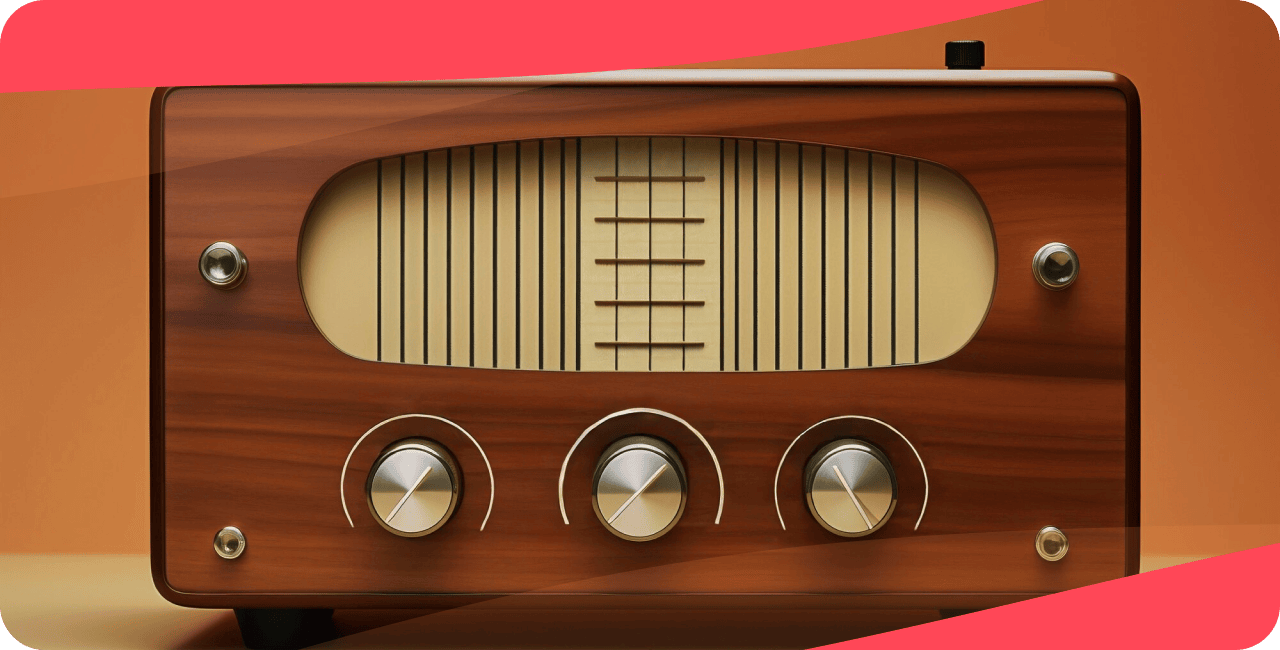1/ The Current State of Radio: A Brief Overview
2/ Reason 1: The Personal Touch of Radio
3/ Reason 2: Accessibility and Convenience
4/ Reason 3: Diversity of Content
5/ Reason 4: The Nostalgia Factor
6/ Reason 5: Innovation in Radio Broadcasting
7/ The Future of Radio: Evolving, Not Dying
8/ Conclusion: The Enduring Legacy of Radio
The Current State of Radio: A Brief Overview
Is radio dying? This is a good question!
Radio, one of the oldest forms of mass media, has been the subject of much debate in recent years, particularly with the rise of digital media. Critics often question its relevance in today’s fast-paced digital world, yet radio continues to demonstrate resilience and adaptability. To understand the depth of radio’s impact and its ability to retain a vast listenership, a comprehensive report by Edison Research offers insightful data. This transition isn’t about radio losing its essence but rather expanding its reach and accessibility. Let’s delve into the current state of radio, focusing on its digital transformation and the evolving listening habits of its audience.
The Digital Transformation
Radio has undergone a significant metamorphosis, seamlessly integrating into the digital landscape. This transition isn’t about radio losing its essence but rather expanding its reach and accessibility. Digital platforms have given radio new life, offering listeners the convenience of streaming their favorite stations and shows from anywhere in the world, at any time. This digital shift has also enabled radio stations to engage with their audiences in real-time through social media, enhancing the listener experience and fostering a stronger sense of community.
Moreover, podcasts and on-demand audio content have become extensions of traditional radio, allowing for more niche and specialized programming. This diversification has not only attracted a broader public but also provided a platform for voices and topics that may not find space in mainstream radio. The essence of radio—storytelling, music, news, and community—remains intact, but the medium’s form and delivery have evolved to meet the digital age’s demands.
Changing Listening Habits
The way people consume media has fundamentally changed, and radio is no exception. With the advent of smartphones and smart speakers, listeners now have unprecedented control over what they listen to, when, and how. This shift towards a more personalized listening experience has impacted traditional broadcast radio, pushing it to innovate and adapt.
Despite these changes, radio continues to play a significant role in many people’s daily routines. It remains a trusted source for local news, emergency broadcasts, and fan engagement. Moreover, the simplicity and accessibility of radio—being free and available to anyone with a receiver—ensure its continued relevance in areas with limited internet access or during times when people prefer the companionship and ease of radio broadcasting.
In conclusion, while the digital transformation and changing listening habits present challenges, they also offer opportunities for radio to evolve and thrive. By embracing digital platforms and adapting to new consumer behaviors, radio continues to be an essential and beloved part of our media landscape.

Reason 1: The Personal Touch of Radio
One of the most compelling reasons radio remains a beloved medium is its unique personal touch, something often lost in the sea of digital content. This personal connection is cultivated through the voices of DJs and radio personalities, and the local flavor of news and events coverage.
DJs and Personalities
Radio DJs and personalities play a pivotal role in forging a deep, personal connection with their public. Unlike the algorithms that curate playlists on digital music services, radio hosts curate their shows based on a mix of personal taste, listener requests, and an intuitive understanding of their audience’s mood and preferences. This human touch adds a layer of warmth and authenticity to the listening experience.
These personalities become familiar voices that accompany listeners through various life moments, from morning commutes to late-night study sessions. They share stories, jokes, and insights, making listeners feel part of a larger community. This relationship is interactive; listeners can call in, request songs, and share their stories, creating a dynamic and engaging experience that’s hard to replicate in other forms of media. For more insights on the importance of radio personalities and how to create an authentic connection with your listeners, check out our article which talks about how to become a good radio host.
Local News and Events
Radio shines in its ability to connect listeners with their immediate public through local news and event coverage. In an age where news is often global and overwhelming, local radio provides a much-needed focus on the happenings within one’s community. This includes everything from weather updates and traffic reports to local government decisions and community events.
This local focus fosters a sense of fan and belonging among listeners. It keeps them informed about their surroundings and encourages active participation in local culture and events. For many, this connection to their audience is a grounding force, reminding them of their place in the wider world and the immediate impact of local news and events on their daily lives.
Discover how RadioKing’s intuitive platform empowers DJs and radio hosts to deepen listener engagement with customizable streaming services. Start your own station with RadioKing today and bring your unique voice to the global stage.

Reason 2: Accessibility and Convenience
Radio’s enduring appeal also lies in its unparalleled accessibility and the sheer convenience it offers to listeners. This section explores how radio’s omnipresence and cost-free nature contribute to its ongoing popularity.
Everywhere You Go
One of radio’s strongest assets is its ubiquity. Radios are embedded in our daily lives, from car dashboards to kitchen counters, making it effortlessly accessible. This ease of access means you can tune into your favorite station whether you’re driving to work, cooking dinner, or relaxing at a picnic. Unlike many digital services that require a stable internet connection, radio’s reach extends to even the most remote areas, ensuring that everyone, regardless of location, can enjoy its offerings.
Moreover, the advent of internet radio and mobile apps has expanded this accessibility even further. Now, listeners are not limited to local frequencies; they can explore stations from around the globe, bringing a world of music, news, and culture right to their fingertips. This blend of traditional and digital access points ensures that radio remains a constant companion, no matter where life takes you.
No Subscription Required
Another significant advantage of radio is that it’s free. There’s no need for subscriptions, memberships, or paywalls. This no-cost accessibility democratizes information and entertainment, ensuring that it’s available to all, regardless of economic status. In an era where many media services require paid subscriptions, radio stands out as a bastion of free, accessible content.
This financial accessibility is particularly important in regions where the cost of internet service or digital subscriptions is prohibitive. Radio provides a vital link to information, entertainment, and emergency broadcasts without adding a financial burden on the listener. It’s this principle of open access that has cemented radio’s place in the hearts and homes of millions worldwide.
RadioKing brings your favorite radio content to your fingertips, offering unparalleled accessibility through user-friendly apps. Tune into a world of music and talk shows with RadioKing’s seamless streaming experience.

Reason 3: Diversity of Content
Radio’s rich tapestry of content is a testament to its adaptability and broad appeal. This diversity, spanning various music genres to an array of talk shows and news formats, ensures that radio has something for everyone.
Music Genres for Every Taste
Radio stations cater to a wide spectrum of musical preferences, offering specialized programs that range from classical to contemporary hits, jazz to electronic dance music, and everything in between. This musical diversity allows listeners to explore new sounds or indulge in their favorite tunes without the need for personalized playlists or streaming services. Specialized music shows often feature expert hosts who provide insights into the music being played, adding depth to the listening immersion. Whether you’re in the mood for soothing classical pieces or upbeat pop songs, radio provides a seamless soundtrack to your day, curated by human touch rather than algorithms.
Talk Shows, News, and Beyond
Beyond music, radio offers a plethora of talk-based programming that engages, informs, and entertains. Talk radio shows delve into topics ranging from politics and current affairs to health, lifestyle, and culture, often featuring expert guests and interactive segments where listeners can contribute their views. This format fosters a deeper understanding of issues and encourages a multiplicity of perspectives.
News programming on radio remains a vital source of information, providing timely updates and in-depth analysis of global events. The immediacy of radio news, coupled with the perspective of seasoned journalists, ensures that listeners are well-informed about the world around them.
Furthermore, radio has embraced storytelling and drama, reviving the art of the audio drama and documentary. These programs offer immersive experiences, using soundscapes and narratives to transport listeners to other times, places, and realities.
Dive into strategies for diversifying your station’s content in our detailed article Radio planning: 3 steps for great programming.

Reason 4: The Nostalgia Factor
Radio holds a unique place in the cultural landscape, often evoking a sense of nostalgia that connects listeners to the past in a deeply personal way. This sentimental value is one of the key reasons for its enduring appeal.
Memories of the Golden Age
For many, radio is a link to the “Golden Age” of broadcasting, a time when radio was the centerpiece of family entertainment and information. The medium’s rich history, from fireside chats to iconic music broadcasts, resonates with listeners who recall tuning in with family and friends. This collective memory, of simpler times centered around the radio’s familiar voice, continues to endear the medium to those who cherish these shared experiences.
Moreover, radio’s role in pivotal moments of history—from broadcasting historic speeches to providing real-time updates during significant global events—has cemented its place in the collective memory. These shared experiences, transmitted through the airwaves, have a unique way of bridging generations, connecting people to their past and to the broader tapestry of human immersion.
The Vinyl Revival Parallel
The resurgence of interest in vinyl records in recent years draws a compelling parallel to radio’s nostalgia factor. Much like vinyl, radio offers an analog charm in a digital world, providing a tactile and authentic immersion that many crave. This revival is not just about the music or the programs but the experience itself—the ritual of tuning in, the anticipation of what will play next, and the connection to a tradition of listening.
This nostalgia is not merely about longing for the past but appreciating the simplicity and authenticity that radio represents. It’s a reminder of a time when entertainment was more about the experience and less about the endless choices. Radio, with its enduring presence and simplicity, offers a respite from the complexity of modern digital life, inviting listeners to slow down and savor the moment.
In summary, the nostalgia factor plays a significant role in radio’s continued relevance. It’s this sentimental connection to the past, coupled with the medium’s ability to evoke shared memories and provide a counterpoint to the digital age’s complexities, that keeps listeners coming back to radio, making it a treasured part of their lives.

Reason 5: Innovation in Radio Broadcasting
Radio has continuously embraced innovation, ensuring its relevance and engagement with contemporary audiences. This adaptability is evident in how radio has integrated with digital platforms and introduced new content formats.
Integrating with Digital Platforms
Radio has successfully bridged the traditional broadcast model with the digital world, enhancing its accessibility and interactivity. For example, many radio stations now offer live streaming services, allowing listeners to tune in via smartphones, tablets, and computers from anywhere in the globe. This digital integration extends to social media, where stations engage with their public through interactive content, listener polls, and real-time discussions, making the radio listening journey more dynamic and connected.
Podcasting is another area where radio has made significant inroads. Traditional radio shows are increasingly available as podcasts, giving listeners the flexibility to catch up on their favorite programs at their convenience. This transition to on-demand audio content allows for deeper dives into niche topics that might not fit the traditional radio schedule, from in-depth interviews and investigative journalism to specialized music shows.
New Formats and New Ways to Engage
Innovation in radio broadcasting is also evident in the exploration of new content formats that cater to evolving listener interests. For instance, immersive audio storytelling has gained traction, with radio producers leveraging binaural sound technology to create rich, spatial audio landscapes that bring stories to life in vivid detail. This technique, reminiscent of the classic radio drama but with a modern twist, offers listeners a captivating auditory journey.
Interactive radio shows have also become more prevalent, where public participation goes beyond simple call-ins or song requests. Technologies like voice recognition and AI are being utilized to create interactive episodes where listeners can influence the story’s direction or outcome, akin to a choose-your-own-adventure book. This level of engagement transforms the listener from a passive consumer to an active participant, deepening their connection to the content.
In summary, radio’s commitment to innovation, through its integration with digital platforms and the exploration of new content formats, ensures its continued relevance and appeal. By adapting to technological advances and shifting listener preferences, radio continues to offer fresh, engaging, and interactive content, proving that this age-old medium can evolve and thrive in the digital era.
The Future of Radio: Evolving, Not Dying
Radio’s ability to adapt and innovate suggests a future where it continues to thrive, shaped by the contributions of local listenership and indie stations and its responsiveness to fan preferences.
The Role of Community and Indie Stations
- Grassroots Broadcasting: Public and independent stations play a crucial role in radio’s ecosystem, often serving as incubators for new talent and experimental content. These platforms provide a voice for underrepresented groups and niche interests, enriching the radio landscape with diverse perspectives.
- Cultural Preservation: Many such stations focus on preserving and promoting local cultures and languages, offering programming that can’t be found on mainstream channels. This commitment to cultural heritage is vital in an increasingly globalized world.
- Innovative Funding Models: To sustain their operations, these stations often rely on innovative funding methods, including crowdfunding, grants, and listener group sponsorships. This approach not only keeps them afloat but also strengthens the bond with their fanbase.
Adapting to Audience Preferences
- Personalized Content: Radio is increasingly leveraging data analytics to understand public preferences, leading to more personalized and targeted programming. This approach ensures that content remains relevant and engaging for a wide spectrum of fan interests.
- Interactive Features: The incorporation of interactive elements, such as real-time polling and audience-driven content, transforms the traditional broadcast model into a two-way dialogue, fostering a deeper engagement with the content.
- Seamless Multi-Platform Presence: Ensuring a consistent and seamless presence across various platforms, from traditional FM/AM to online streaming and social media, radio is meeting its audience wherever they are, with content that resonates with their daily lives and interests.
In conclusion, radio’s future looks promising, driven by its ability to evolve with technological advancements and changing public needs. The continued vitality of public and indie stations, coupled with the medium’s adaptability to audience preferences, underscores radio’s enduring appeal and its potential for ongoing innovation and growth.

Conclusion: The Enduring Legacy of Radio
Radio has consistently demonstrated its resilience and capacity for innovation, ensuring its place in the dynamic landscape of media. This enduring legacy is rooted in its ability to adapt and resonate with a diverse and evolving fanbase.
A Medium That Adapts and Thrives
Radio’s journey through the decades showcases a remarkable ability to embrace change and new technology, ensuring its relevance and appeal. From the transition to digital broadcasting to the integration of interactive and on-demand content, radio has continually evolved. This adaptability is a testament to the medium’s inherent strengths: its immediacy, its accessibility, and its capacity to foster a unique connection with its public. As we look to the future, these qualities suggest a bright trajectory for radio, one that will likely see it continue to innovate and serve as a vital source of entertainment, news, and engagement.
Why We’ll Continue to Tune In
The reasons to keep tuning into radio are as varied and dynamic as the medium itself. From the comfort of familiar voices to the thrill of discovering new music or insights, radio offers a personalized and engaging immersion that stands apart in the digital age. Its role in providing timely information, coupled with the ease of access—requiring no subscriptions or complex setups—ensures its place in our daily lives. Moreover, the diversity of content, from niche music programs to compelling talk shows and storytelling, guarantees that there is always something for every taste and interest.
In essence, radio’s legacy is not just about the technology or the content but about the enduring connections it fosters. Whether through the shared joy of a favorite song or the collective experience of a significant news event, radio continues to bring people together, transcending geographical and cultural boundaries. It is this ability to adapt, innovate, and connect that will ensure radio’s place in our hearts and homes for generations to come.
If you liked this article, feel free to like and comment on it!
